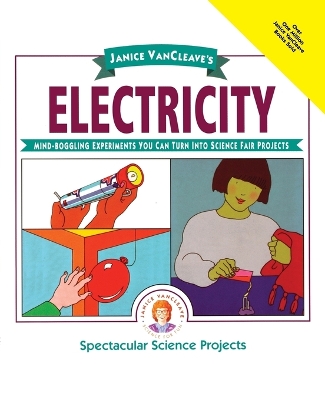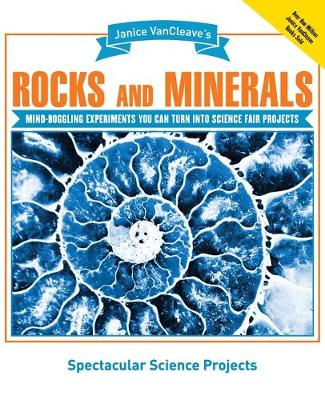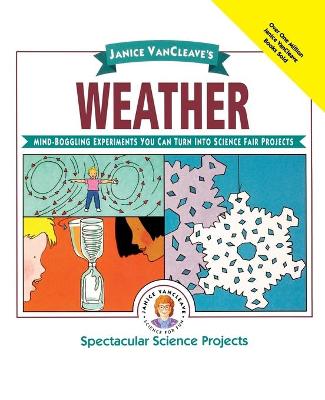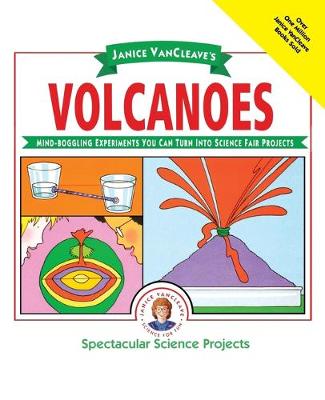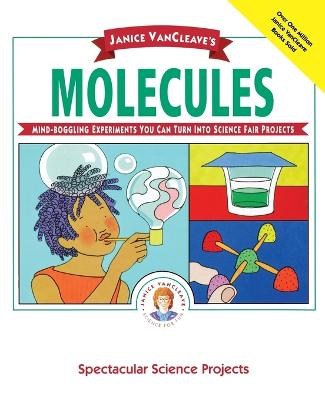Spectacular Science Project
2 primary works • 6 total works
Book 10
The perfect science fair idea books . Spectacular Science ProjectsJanice Vancleave's Electricity
* How do you make a battery out of a lemon?
* Can a magnet produce electricity?
* How does a flashlight work?
Janice VanCleave's Electricity includes 20 simple and funexperiments that allow you to discover the answers to these andother fascinating questions about electricity, plus dozens ofadditional suggestions for developing your own science fairprojects. Learn about electric charges with a simple experimentusing modeling clay and a plastic straw; about voltage using abowl, paper towels, and a raw egg; about conductors with someclothespins, aluminum foil, and a flashlight bulb; and much more.All experiments are safe, use inexpensive household materials, andinvolve a minimum of preparation and clean up. Children ages 8-12Also available in the Spectacular Science Projects Series: JaniceVanCleave's Animals Janice VanCleave's Earthquakes JaniceVanCleave's Gravity Janice VanCleave's Machines Janice VanCleave'sMagnets Janice VanCleave's Molecules Janice VanCleave's Microscopesand Magnifying Lenses Janice VanCleave's Volcanoes JaniceVanCleave's Weather
* How do you make a battery out of a lemon?
* Can a magnet produce electricity?
* How does a flashlight work?
Janice VanCleave's Electricity includes 20 simple and funexperiments that allow you to discover the answers to these andother fascinating questions about electricity, plus dozens ofadditional suggestions for developing your own science fairprojects. Learn about electric charges with a simple experimentusing modeling clay and a plastic straw; about voltage using abowl, paper towels, and a raw egg; about conductors with someclothespins, aluminum foil, and a flashlight bulb; and much more.All experiments are safe, use inexpensive household materials, andinvolve a minimum of preparation and clean up. Children ages 8-12Also available in the Spectacular Science Projects Series: JaniceVanCleave's Animals Janice VanCleave's Earthquakes JaniceVanCleave's Gravity Janice VanCleave's Machines Janice VanCleave'sMagnets Janice VanCleave's Molecules Janice VanCleave's Microscopesand Magnifying Lenses Janice VanCleave's Volcanoes JaniceVanCleave's Weather
Book 11
What are fossils?
* How do stalactites and stalagmites form?
* Can rock melt?
Janice VanCleave's Rocks and Minerals includes 20 fun and simpleexperiments that allow you to discover the answers to these andother fascinating questions about rocks and minerals, plus dozensof additional suggestions for developing your own science fairprojects.
See how sedimentary rock is formed using two pillows, a yardstick,and some masking tape. Make models of rocks and minerals withgumdrops, toothpicks, and plastic bags. Learn what carbonateminerals are and how to identify them using a glass jar, somevinegar, and an egg. All experiments use inexpensive householdmaterials and involve a minimum of preparation and clean up.
Children ages 8-12
Also available in the Spectacular Science Projects series:
Janice VanCleave's Animals
Janice VanCleave's Earthquakes
Janice VanCleave's Electricity
Janice VanCleave's Gravity
Janice VanCleave's Machines
Janice VanCleave's Magnets
Janice VanCleave's Molecules
Janice VanCleave's Microscopes and Magnifying Lenses
Janice VanCleave's Volcanoes
Janice VanCleave's Weather
* How do stalactites and stalagmites form?
* Can rock melt?
Janice VanCleave's Rocks and Minerals includes 20 fun and simpleexperiments that allow you to discover the answers to these andother fascinating questions about rocks and minerals, plus dozensof additional suggestions for developing your own science fairprojects.
See how sedimentary rock is formed using two pillows, a yardstick,and some masking tape. Make models of rocks and minerals withgumdrops, toothpicks, and plastic bags. Learn what carbonateminerals are and how to identify them using a glass jar, somevinegar, and an egg. All experiments use inexpensive householdmaterials and involve a minimum of preparation and clean up.
Children ages 8-12
Also available in the Spectacular Science Projects series:
Janice VanCleave's Animals
Janice VanCleave's Earthquakes
Janice VanCleave's Electricity
Janice VanCleave's Gravity
Janice VanCleave's Machines
Janice VanCleave's Magnets
Janice VanCleave's Molecules
Janice VanCleave's Microscopes and Magnifying Lenses
Janice VanCleave's Volcanoes
Janice VanCleave's Weather
The perfect science fair idea books . Spectacular Science ProjectsJanice VanCleave's Weather
* Why does it rain?
* What causes thunder and lightning?
* How does a cloud form?
Janice VanCleave's Weather includes 20 fun and simple experimentsthat allow you to discover the answers to these and otherfascinating questions about weather, plus dozens of additionalsuggestions for developing your own science fair projects. Learnwhat causes lightning with a simple experiment using a roll of tapein a darkened room. Make a barometer from a soda bottle, straws,modeling clay, and colored water. Use a shoe box, plastic wrap, andsome soil to understand the greenhouse effect. All experiments useinexpensive household materials and involve a minimum ofpreparation and cleanup. Children ages 8-12 Also available in theSpectacular Science Projects Series Janice VanCleave's AnimalsJanice VanCleave's Earthquakes Janice VanCleave's ElectricityJanice VanCleave's Gravity Janice VanCleave's Machines JaniceVanCleave's Magnets Janice VanCleave's Molecules Janice VanCleave'sMicroscopes and Magnifying Lenses Janice VanCleave's VolcanoesKids.
* Why does it rain?
* What causes thunder and lightning?
* How does a cloud form?
Janice VanCleave's Weather includes 20 fun and simple experimentsthat allow you to discover the answers to these and otherfascinating questions about weather, plus dozens of additionalsuggestions for developing your own science fair projects. Learnwhat causes lightning with a simple experiment using a roll of tapein a darkened room. Make a barometer from a soda bottle, straws,modeling clay, and colored water. Use a shoe box, plastic wrap, andsome soil to understand the greenhouse effect. All experiments useinexpensive household materials and involve a minimum ofpreparation and cleanup. Children ages 8-12 Also available in theSpectacular Science Projects Series Janice VanCleave's AnimalsJanice VanCleave's Earthquakes Janice VanCleave's ElectricityJanice VanCleave's Gravity Janice VanCleave's Machines JaniceVanCleave's Magnets Janice VanCleave's Molecules Janice VanCleave'sMicroscopes and Magnifying Lenses Janice VanCleave's VolcanoesKids.
The perfect science fair idea books
Spectacular Science Projects Janice VanCleaves Volcanoes
- Why do volcanoes erupt?
- How do scientists predict volcanoes?
- Where are most volcanoes found?
The perfect science fair idea books. Spectacular Science ProjectsJanice VanCleave's Molecules
* What are molecules made of?
* How do water molecules stay together?
* How does heat affect the movement of molecules?
Janice VanCleave's Molecules includes 20 simple and fun experimentsthat allow you to discover the answers to these and otherfascinating questions about molecules, plus dozens of additionalsuggestions for developing your own science fair projects. Learnabout the structure of molecules with a simple experiment using gumdrops and toothpicks; about molecular motion with a glass, a cup,and food coloring; about crystals using Epsom salts, a soap dish,and a paint brush; and much more. All experiments use inexpensivehousehold materials and involve a minimum of preparation and cleanup. Children ages 8-12 Also available in the Spectacular ScienceProjects series: Janice VanCleave's Animals Janice VanCleave'sGravity KIDS.
* What are molecules made of?
* How do water molecules stay together?
* How does heat affect the movement of molecules?
Janice VanCleave's Molecules includes 20 simple and fun experimentsthat allow you to discover the answers to these and otherfascinating questions about molecules, plus dozens of additionalsuggestions for developing your own science fair projects. Learnabout the structure of molecules with a simple experiment using gumdrops and toothpicks; about molecular motion with a glass, a cup,and food coloring; about crystals using Epsom salts, a soap dish,and a paint brush; and much more. All experiments use inexpensivehousehold materials and involve a minimum of preparation and cleanup. Children ages 8-12 Also available in the Spectacular ScienceProjects series: Janice VanCleave's Animals Janice VanCleave'sGravity KIDS.
The perfect science fair idea books. Spectacular Science ProjectsJanice VanCleave's Magnets
* How does a compass work?
* What is a magnetic field?
* How can you make a magnet with electricity?
Janice VanCleave's Magnets includes 20 simple and fun experimentsthat allow you to discover the answers to these and otherfascinating questions about magnets, plus dozens of additionalsuggestions for developing your own science fair projects. Learnabout magnetic poles using a bar magnet, paper, and string; aboutmagnetic force fields with a compass, a pencil, and a sheet ofpaper; and much more. All experiments use inexpensive householdmaterials and involve a minimum of preparation and clean up.Children ages 8-12 Also available in the Spectacular ScienceProjects Series: Janice VanCleave's Animals Janice VanCleave'sEarthquakes Janice VanCleave's Electricity Janice VanCleave'sGravity Janice VanCleave's Machines Janice VanCleave's MoleculesJanice VanCleave's Microscopes and Magnifying Lenses JaniceVanCleave's Volcanoes Janice VanCleave's Weather
* How does a compass work?
* What is a magnetic field?
* How can you make a magnet with electricity?
Janice VanCleave's Magnets includes 20 simple and fun experimentsthat allow you to discover the answers to these and otherfascinating questions about magnets, plus dozens of additionalsuggestions for developing your own science fair projects. Learnabout magnetic poles using a bar magnet, paper, and string; aboutmagnetic force fields with a compass, a pencil, and a sheet ofpaper; and much more. All experiments use inexpensive householdmaterials and involve a minimum of preparation and clean up.Children ages 8-12 Also available in the Spectacular ScienceProjects Series: Janice VanCleave's Animals Janice VanCleave'sEarthquakes Janice VanCleave's Electricity Janice VanCleave'sGravity Janice VanCleave's Machines Janice VanCleave's MoleculesJanice VanCleave's Microscopes and Magnifying Lenses JaniceVanCleave's Volcanoes Janice VanCleave's Weather
